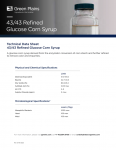The clean label hierarchy: Xanthan gum? No chance. Guar gum? Borderline. Sugar? Bring it on…

If it starts with an x, sounds like a chemical, or isn’t in your kitchen cupboard, shoppers may regard it with suspicion, says the firm, which has grouped many common food ingredients and additives into three groups (acceptable, borderline, not acceptable) based on consumer research.
Indeed, the name appears to trump everything else, with the unfortunately-named xanthan gum, polysorbate, microcrystalline cellulose, mono-diglycerides, carboxymethyl cellulose, bleached flour and modified starch all in the ‘unacceptable’ group for firms keen to clean up labels.
Meanwhile, even ingredients from 'natural' sources including maltodextrin (from corn or wheat starch), guar gum (from guar beans), pectin (from fruits), and lecithin (from soybeans or sunflower oil) are in the ‘borderline’ group because shoppers either do not recognize them as ‘natural’ from their names or do not routinely stock them in their kitchen cupboards.
Cleanlabelinsights.com
The cleanlabelinsights.com website will help manufacturers develop formulations with more consumer-friendly ingredient lists and front-of-pack claims, says the firm, which has pioneered developments in clean label functional native starches.
“This initiative will enable us to present and share an in-depth understanding of consumer attitudes and strengthen our position as the industry authority and go-to clean label partner", said Aaron Edwards, global director of wholesome for Corn Products/National Starch, which has developed its own working definition of clean label.
This advises manufacturers that want to ‘clean up’ labels to follow three rules:
- Remove or replace food additives.
- Choose recognizable ingredients that do not sound chemical or artificial.
- Process foods using traditional techniques that are understood by consumers and not perceived as being artificial.
Consumer research
Consumer research conducted by MMR Research Worldwide for National Starch last year in the US, the UK, France, Germany, Italy and Spain, found that two thirds of respondents rated ‘no additives’ / ‘no artificial ingredients’ as an important purchasing factor and that 76% see a short and simple ingredient list as important.
Starch is more acceptable than modified starch, and baby foods, dairy products and meat are the most important food categories to be ‘additive-free’.
Meanwhile, a minimally processed claim would cause 38% of US consumers to consider switching from their usual brand.
Is clean about more than just the ingredients list?
While Whole Foods Market has famously published a list of ‘unacceptable’ ingredients, the concept of clean is not simply about (un) acceptable ingredients, but a rather more nebulous concept, according to consultancy Hartman Group.
“To consumers clean has both symbolic associations (fresh, safe, local, healthy) and objective associations (less processed, no chemicals, nothing artificial). Clean food is: natural, organic, local, sustainable, fresh, safe, ethical and healthy.”
Speaking to FoodNavigator-USA in February, Scott Martling from product development consultancy International Food Network, said: “A conventional consumer products manufacturer wanting to market a minimally processed product should consider offering a suite of benefits including, but certainly not limited to: recognizable ingredients, visually recognizable bits, minimal packaging, and a reasonable shelf life.
“If in doubt, ask yourself if a consumer would expect a homemade version of this product to last 24+ months?”
What are the wider implications of the clean label trend?
However, many industry observers argue the preoccupation with clean labels is diverting attention from more substantive nutritional issues (fat/sugar/sodium reduction, nutrient density) and fueling an irrational ‘chemophobia’ in consumers.
As Fergus Clydesdale, distinguished professor at the University of Massachusetts, observes: “Is shortbread made of butter and sugar in the kitchen healthier than a packaged dessert with sugar and fat in it?”
As for the obsession with ridding food labels of ‘chemicals’, he says: “We are made of chemicals as are foods as is everything else.”
Click here to find out more about Corn Products International's plan to change its name to Ingredion.





















